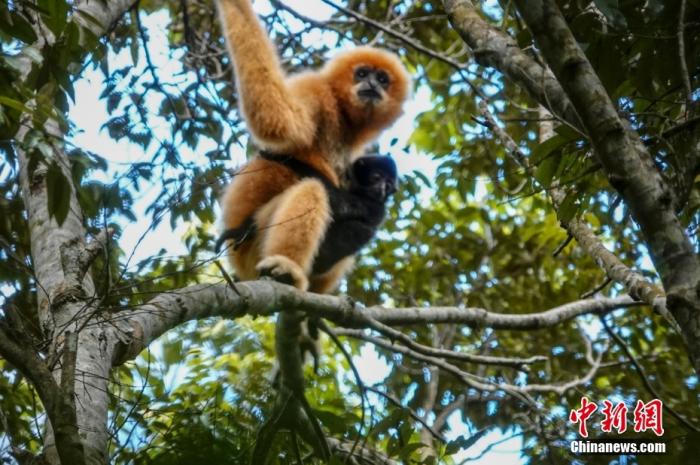China News Agency, Beijing, March 3 (Reporter Chen Su) The 3rd is the ninth "World Wildlife Day". The reporter learned from the State Forestry and Grassland Administration of China that positive progress has been made in the protection of China's flagship species and will be further implemented. Rescue protection of 48 critically endangered wild animals.
Hainan gibbon.
(File photo) Photo courtesy of Hainan Tropical Rainforest National Park Administration issued by China News Agency
In recent years, China has rescued 12 flagship species including giant panda, Asian elephant, Hainan gibbon, western black crested gibbon, leopard, Chinese pangolin, Yunnan snub-nosed monkey, Guizhou snub-nosed monkey, tiger, crested ibis, green peacock and four-clawed tortoise. Protect.
At present, the number of giant pandas has increased from 1,114 in the 1970s and 1980s to 1,864, and the total number of captive populations in the world is 673; the number of Asian elephants has increased from 180 in 1985 to about 300; the population of Hainan gibbons has been insufficient from 1980. 10 recovered to 5 groups of 35; crested ibis increased from 7 when it was discovered in 1981 to more than 5,000; the number of wild Amur tigers and Amur leopards in the Siberian Tiger and Leopard National Park exceeded 50 and 60 respectively; black crested gibbons increased to about 700; wild green peacocks increased to about 550; the population of Yunnan snub-nosed monkeys increased to more than 3,800.
In order to strengthen the protection of wild animals and plants, China has implemented projects such as wildlife habitat protection and rescue and breeding, in situ protection of wild plants and returning to nature, effectively protecting 90% of vegetation types and terrestrial ecosystems, and 65% of higher vegetation. Plant communities, 85% of the key protected wildlife populations.
The first batch of national parks such as Sanjiangyuan, Giant Panda, Siberian Tiger and Leopard, Hainan Tropical Rainforest, and Wuyi Mountain have been established, with a protected area of 230,000 square kilometers, covering nearly 30% of the terrestrial national key protected wild animal and plant species.
At the same time, the illegal trade of wild animals and plants has been severely cracked down, and the bad habit of eating wild animals has been eliminated, and the protection level of wild animals and plants has been continuously improved.
On December 20, 2013, the 68th United Nations General Assembly decided to set March 3 every year as "World Wildlife Day". This year's global theme is "Restore key species and restore ecosystems".
With the theme of "Focusing on the Protection of Flagship Species and Promoting the Construction of a Beautiful China", China aims to mobilize the whole society to participate in the protection of flagship species more widely and more closely.
The relevant person in charge of the State Forestry and Grassland Administration stated that during the "14th Five-Year Plan" period (2021-2025), China will implement 48 critically endangered species including giant pandas, Asian elephants, Hainan gibbons, Siberian tigers, Chinese pangolins, and four-clawed tortoises. Rescue protection of wild animals and 50 species of wild plants in very small populations, such as Baishanzu fir, Qiaojia five needles pine and white flower, and their habitats; delineate and strictly protect important habitats, connect ecological corridors, and ensure important habitats The land area has increased by 10%; the provenance breeding base and genetic resource gene bank of rare and endangered wild animals have been built, and 15 rare and endangered wild animals such as giant panda, Przewalski’s horse, elk, and crested ibis have been reintroduced into the wild; 100 species of plants, such as Metasequoia and Dipterocarpus tokyo, whose numbers are scarce or whose habitats are severely damaged, are protected by ex situ conservation and the minimum artificial population is preserved.
(over)

